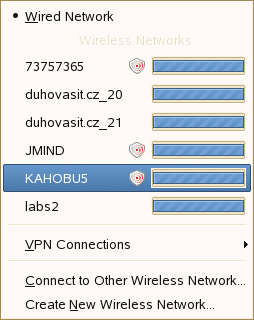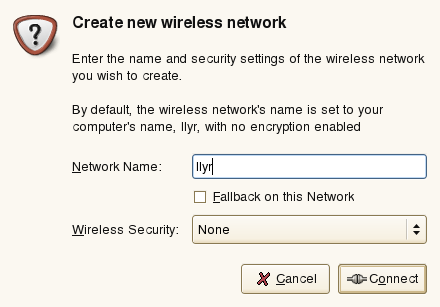10.4 The GNOME NetworkManager Applet
In GNOME, the NetworkManager can be controlled with the GNOME NetworkManager applet. The GNOME NetworkManager applet should start automatically with the desktop environment and is then shown as an icon in the system tray. The appearance of the icon depends on the state of the network connection. Hold the mouse cursor over it until an explanation appears. Using the applet, choose a network to use explicitly at any time. Such a choice takes priority over automatically selected networks. The chosen network is used as long as it is available, meaning that plugging a network cable in does not switch to a wired network connection automatically.
If the GNOME NetworkManager applet does not start automatically, start it with the command nm-applet.
Left-click the applet icon to show a menu with available wired and wireless networks, shown in Figure 10-2. The currently used connection is checked in the menu. To connect to a network, choose it from the list. To disable networking, right-click the applet icon and uncheck .
Figure 10-2 Available Networks in GNOME NetworkManager Applet

To get information about the current connection (including the used interface,
IP address, and hardware address), right-click the applet icon and choose
from the menu. In this dialog, you
can also configure your network devices. To do so, click . It opens YaST where you can define a new
connection. See Section 20.4, Configuring a Network Connection with YaST,
(↑ Reference ) for more information.
10.4.1 Wireless Networks
Available visible wireless networks are listed in the GNOME NetworkManager applet menu under . The signal strength of each network is also shown in the menu. Encrypted wireless networks are marked with a shield icon. To connect to a wireless network, choose it from the menu. If the network is encrypted, choose the type of the network uses and enter the appropriate or in the dilaog that opens.
HINT: Hidden Networks
To connect to a network that does not broadcast its service and therefore cannot be detected automatically, set the identifier (ESSID). Left-click the icon and choose . In the dialog that opens, enter the (ESSID) and set encryption parameters, if necessary. If you check , NetworkManager will try to access a network with this ESSID in situations where no trusted network is accessible.
If your wireless card supports access point mode, you can use NetworkManager for the configuration. To configure your wireless card as an access point, click . See Figure 10-3. Add the network name and set the encryption in the .
IMPORTANT: Wireless Security
If you set to None,
everybody can connect to your network, reuse your connectivity and
intercept your network connection. To restrict access to your access point
and to secure your connection, use encryption. You can choose between various
WEP and WPA–based encryptions. If you are not sure which technology
is best for you, read Authentication,
(↑ Reference ).
Figure 10-3 Access Point Configuration

To disable wireless networking, right-click the applet icon and uncheck .
10.4.2 Dial-Up Connections
To control dial-up connections with the GNOME NetworkManager applet, you have to configure them in YaST first. The dial-up connections will then be available in the GNOME NetworkManager applet menu. Support for direct configuration of dial-up connections in NetworkManager is planned for future versions. For the latest informations read the files in /usr/share/doc/packages/NetworkManager.
10.4.3 VPN Connections
NetworkManager supports several VPN technologies. To use them, first install NetworkManager support for your VPN technology. You can choose between:
-
NovellVPN
-
OpenVPN
-
vpnc (Cisco)
VPN support is included in the packages NetworkManager-novellvpn, NetworkManager-openvpn, and NetworkManager-vpnc. If you are using the GNOME NetworkManager applet you also need the GNOME specific packages NetworkManager-novellvpn-gnome, NetworkManager-openvpn-gnome, and NetworkManager-vpnc-gnome.
To configure a new VPN connection with the GNOME NetworkManager applet, left-click the GNOME NetworkManager applet icon and follow these steps:
-
Choose .
-
In the dialog that opens, press to start a configuration wizard.
-
Choose the type of VPN connection to create in .
-
Name your configuration in . This name will be used for identifying the connection to the private network.
-
Choose the type of VPN connection to create in .
-
Insert all for your type of connection. For example, for an OpenVPN connection enter and choose the way to authenticate in . Complete the other required options depending on the connection chosen.
-
Press .
10.4.4 Switching Off the Network in GNOME
If you are on an airplane or in any other environment where wireless networking is not allowed, you can switch it off easily using the GNOME NetworkManager applet. You can also switch off all network connections, both wired and wireless.
To switch off wireless networking in the GNOME desktop, right-click the GNOME NetworkManager applet and uncheck . To switch wireless networking on again check that option again.
To switch off all networking in the GNOME desktop, right-click the GNOME NetworkManager applet and uncheck To switch all networking on again check that option again.